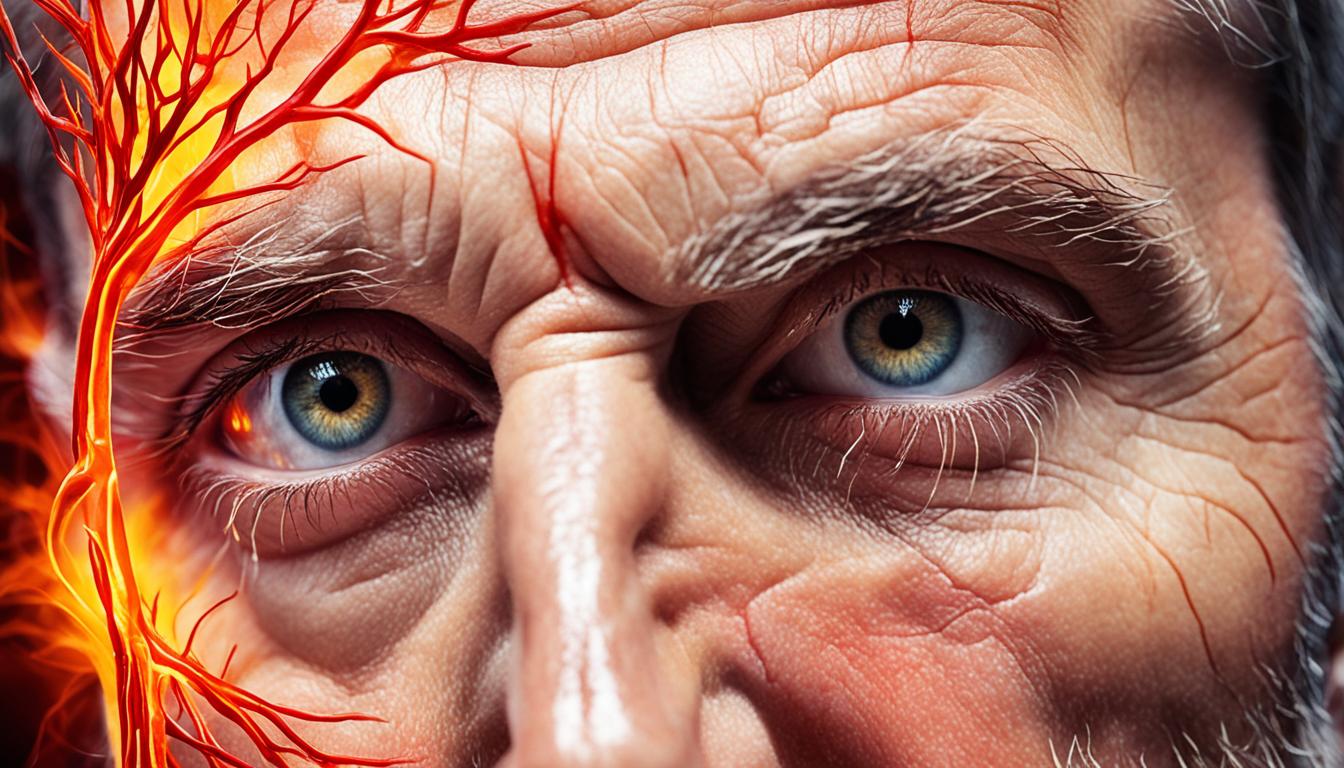Postherpetic neuralgia (PHN) comes after the varicella-zoster virus (VZV) reactivates. This reactivation is known as shingles. PHN causes a sharp or burning pain in one part of the body that lasts for months. It’s more common in older people and those with weaker immune systems.
The VZV virus stays dormant in nerve clusters after chickenpox heals. We don’t fully know why some get PHN while most don’t. Studies show nerve damages in those with PHN, including myelin and axon problems and changes in the spinal cord.
Doctors diagnose PHN based on your history and symptoms. You might feel stabbing or burning pain, or even itchiness where shingles appeared. Treatments include various medications, nerve blocks, and even modern therapies like spinal cord stimulation and cognitive therapy. Getting vaccinated is the best way to prevent shingles and PHN.
Key Takeaways:
- Postherpetic neuralgia (PHN) can happen after shingles and cause long-lasting pain.
- It feels like a continuous sharp or burning pain in one body area.
- Older people and those with weakened immune systems are more at risk.
- Treatment includes many medications and new therapies like spinal cord stimulation.
- Shingles vaccination is highly recommended to avoid the disease and its aftermath.
Symptoms of Postherpetic Neuralgia
Postherpetic neuralgia (PHN) comes with a range of symptoms. These can really affect someone’s daily life. Knowing about these symptoms is key to getting diagnosed early and managing them well.
- Stabbing, Aching, or Burning Pain: One main symptom of PHN is a sharp or burning pain that follows a specific skin area. This kind of pain can be strong and stop you from living your life fully.
- Increased Sensitivity: Even a simple touch, like the light rubbing of clothes, can make the pain worse. This is called allodynia and it makes normal tasks hard and painful.
- Itchiness and Numbness: Some people with PHN might also feel itchy or numb where they once had shingles. These feelings add to the overall discomfort of the condition.
- Aggravation by Temperature Changes: Big changes in temperature, going from hot to cold or vice versa, can make the pain more intense. It’s important to stay away from things that make your symptoms worse.
- Persistent Pain: The pain from PHN can last over three months after the shingles rash goes away. Sometimes it can last a year or more. This pain can really change how someone lives every day and feels.
- Disrupted Sleep and Concentration: The ongoing pain from PHN can lead to problems with sleeping, eating less, and not being able to focus well. These issues can affect parts of your life and how you function.
If you think you might have PHN, it’s important to see a doctor. A doctor can help you get the right treatment early. Early treatment can make the pain better and improve your life.
Treatment Options for Postherpetic Neuralgia
Dealing with postherpetic neuralgia (PHN) symptoms may be tough. But, there are many treatments available. These can help people with PHN feel better and enjoy life more.
Medications: Doctors often use a mix of drugs to treat PHN pain. Over-the-counter pain meds like NSAIDs can lessen mild to moderate pain. Skin patches with lidocaine or capsaicin can give relief right where it hurts. Antidepressants and anticonvulsants help with nerve pain. For severe pain, doctors might suggest opioid drugs.
Nerve Blocks and Corticosteroid Injections: Nerve blocks and corticosteroid shots work well for those with ongoing, severe pain. Nerve blocks aim to numb the nerves temporarily. Shots of corticosteroids can decrease swelling and pain.
Spinal Cord Stimulation: Considered a modern way to tackle chronic pain, spinal cord stimulation is when a device is put in that sends weak electrical signals. These signals change how the brain sees pain. Though it’s still being researched, it looks good for treating different types of long-lasting pain, like PHN.
Non-Medical Techniques: Besides medicines, there are non-drug ways to ease PHN. Things like therapy, deep breathing, meditation, biofeedback, and acupuncture can help lower pain and make someone feel better.
Everyone’s journey with PHN is unique. Also, not all treatments work for everyone. It’s wise to talk to a healthcare expert, like a pain doctor, to find the best treatment for postherpetic neuralgia.
Conclusion
Postherpetic neuralgia (PHN) is tough and can change how someone lives. It causes long-term nerve pain after a shingles outbreak. PHN can stop people from doing things and make them very uncomfortable. Luckily, there are ways to help manage the pain and make symptoms better.
Medicine like over-the-counter pain relief and some antidepressants can ease PHN symptoms. Treatments such as nerve blocks and shots with corticosteroids can also help for a while. They work by reducing pain and swelling. New methods such as spinal cord stimulation are also proving effective.
Non-medicine methods, like talking therapy and acupuncture, can make pain easier to handle. Researchers are also looking into using stem cells to treat PHN. Getting the shingles vaccine is a good way to avoid PHN.
If you think you have shingles or PHN symptoms, talk to a pain expert. They can give you the right help and a plan just for you. By using all the available ways to treat PHN, there is real hope for people with this condition.

